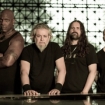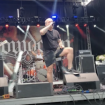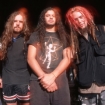On October 30th, 1987, Sepultura released their second LP, Schizophrenia, in their home country of Brazil. The record— which proved to be highly influential in the death-metal and thrash worlds — might never have reached U.S. shores had it not been for a young A&R scout named Monte Conner, who signed them to what was at the time a small metal label called Roadrunner Records. (Conner would go on to sign many more of the greatest metal acts of our time, including Slipknot, Type O Negative, Machine Head and Gojira.)
Revolver spoke with Conner about how Sepultura — which then featured singer-guitarist Max Cavalera, lead guitarist Andreas Kisser, bassist Paulo Jr. and drummer Igor Cavalera — came across his radar, as well as what drove him to sign the group before ever seeing them play live and what he heard on those initial tapes that made the band so special.
HOW DID YOU FIRST DISCOVER SEPULTURA?
MONTE CONNER Back in the Eighties, I was just a huge metal fan and was totally plugged into the scenes back as a teenager in New York. I read fan zines, went to concerts and had my hand on the pulse of what was going on in the underground music scene. It wasn't just me — there was a group of friends — one guy was Don Kaye [Kerrang!] and another was Borivoj Krgin [Blabbermouth]. We were kind of the three musketeers of the New York scene. We knew everything that was going on in the underground — every demo, every band — we were just as plugged in as anyone could possibly be.
Sepultura were discovered by Don Kaye, who got a tape from one of his tape-trading contacts in Brazil. This guy sent him a compilation of demos by six bands. On this tape was Sepultura's five-song Bestial Devastation EP. As far as I know, no one of note outside of Brazil had heard Sepultura before Don got this tape. He freaked out and turned Borivoj and I onto it, and we loved it as well. Of course, that's kind of laughable because if you listen now — it's primitive. It's really not even that good, but back then when we heard it, it was mind-blowingly cool and different. So that's how the band came onto my radar, through Don Kaye.
I was in college from '82-'87 and was a DJ at the school radio station. I was playing all this stuff, and was also in touch with record labels because Metal Blade, Megaforce and others were servicing me with records to get played at the college radio station. So I had connections to some of these labels and would hear about bands, and occasionally I would get in touch with the people at Metal Blade or Combat saying, "Hey, you should sign this band or that band." Of course, they didn't take me seriously — I was just some snot-nose DJ, but I was a wannabe A&R guy because I was very plugged into the scene. I wasn't in any type of position to do anything because I wasn't working at a label yet. So long story short, when I started at Roadrunner in December '87, I took stock of all these bands I knew about that were looking for deals, one of which was Sepultura, and then tried to get some of these bands signed. So Sepultura were actually the second band that I ever signed to Roadrunner under my tenure.
SO YOU JUST SIGNED THEM ON THE STRENGTH OF THEIR RECORDED MATERIAL ALONE? DID ANYBODY SEE THE BAND OR HAVE FIRST-HAND KNOWLEDGE OF THIS BAND?
No, no. When I brought the band to the owner of Roadrunner, this would have been in January of 1988, I played him the Schizophrenia record because that was out already in Brazil. To me, Schizophrenia was such a monumental leap up from Morbid Visions and Bestial Devastation. People like to joke about the fact that on Morbid Visions the guitars were not even in tune on the recording. [Laughs] The thing is, Andreas [Kisser] was a technician. He was, by far, the guy in the band with the most musical ability and the most talent at that stage. So he really added a whole degree of musicality and maturity to the band. So that's why from Morbid Visions to Schizophrenia was such a massive growth in every direction — from the playing to the writing to the production. To this day, Sepultura would never have happened to the extent they did without the partnership between Max and Andreas. That was where the magic of Sepultura lied. This, of course, was not to take anything away from Iggor [Cavalera], obviously an amazing powerhouse drummer. But it was really the combination of Max and Andreas together that kind of was to me the secret sauce of Sepultura.
THE SENSE I'M GETTING IS THAT THE KISSER/CAVALERA RELATIONSHIP CREATED A PUSH/PULL THAT BALANCED OUT WELL.
Yeah, I guess. Andreas just had a musicality about him. He was a great player. I guess if you could provide an analogy, it'd be that Max would make this amazing painting, but then Andreas would add the flourishes and the color and the little things that made the painting special and ultimately stand out. Like, in other words, you needed both guys. I think, Max, from what I could tell, was a little bit more the foundational guy in the band that came up with most of the riffs — I don't want to say most, but let's just say a large portion of the riffs and ideas — and then Andreas would kind of come and finish it off. It's really no different than if you look at the situation of many bands we have like Plant/Page or Jagger/Richards. So many bands out there had this amazing partnership between guitar player and the singer. This was another one of those.
SO BACK TO THEIR SIGNING IN EARLY 1988: YOU HAD NEVER MET BEFORE, NOR HAD YOU SEEN THE BAND LIVE.
Correct. I signed them in March '88 and I'd never met them. They were playing live shows in Brazil at that point, but to be honest, it never really dawned on me to get on a plane and go see them. I was four months into the job. I didn't really know what the hell I was doing. You know, the idea of getting on a plane to go to a foreign land to see an exotic band, it didn't even dawn on me, but I assumed that the band could play. So I basically signed them sight unseen.
It was very difficult to communicate with Sepultura at the start, because Max was the only member who spoke even a little bit of English. All my communication with Max and the band was through this guy they knew named Lino, who was from their hometown, Belo Horizonte. Lino would have to be there with them whenever I called so that he could translate. [Roadrunner] were very nervous about the fact that we had never signed a band from Brazil, and were concerned about whether the contract would be legally binding in as well as outside of Brazil. One of the things I did, because we were a small label and I wore many hats — I was the radio promotion guy, label manager and publicist as well as head of A&R — was to take the contracts to the Brazilian consulate in New York and have them notarized and on file to show that they were legal documents. We also had the contracts translated into Portuguese, because we wanted to be able to prove that the band knew what they were signing. We went through a lot of steps to make sure we were doing things 100 percent legally. I can't recall if they took the contract to a lawyer in Brazil: They were just young kids and very anxious to sign a deal, any deal.
ONCE YOU FINALLY MET SEPULTURA, WHAT WERE YOUR INITIAL THOUGHTS ON THEM?
Max had a friend in Brazil who worked for Pan Am Airlines who got him free roundtrip tickets to the U.S. When Max arrived here in February 1988, I was already in touch with him and interested in signing a deal with Sepultura. Max was only in New York for three days, and arrived with a piece of paper that listed the studio rates for Nas Nuvens Studio in Rio, where Beneath the Remains was to be recorded. We met at the Roadrunner office one of those days and hung out for a few hours. I didn't meet the full band until after Beneath the Remains had been recorded and they played their first New York show on tour in support of that. Their English was a little dicey still, so it was still a little bit tough to communicate, but they were certainly friendly guys. They seemed very, very hungry and just beyond excited to be in the U.S. touring. You know it was just an amazing experience for them to be here for the first time.
WHAT ABOUT THE FIRST TIME YOU SAW THEM PERFORM LIVE? WERE THEY EVERYTHING YOU HOPED THEY WOULD BE? HOW WOULD YOU CLASSIFY THEM?
Well, when I saw them live for the first time, it was at a shithole in New York called Zone D.K. It was on the West Side and was actually a sex club that had live shows. So it wasn't really the best place to see the band, but they were on fire. They were just young, full of energy, and I was definitely very pleased with them live. I thought that they delivered the energy and the playing ability that you heard on Beneath the Remains. They were able to do that live easily.
GOING BACK TO SCHIZOPHRENIA, WHAT DO YOU THINK ARE THE STANDOUT MOMENTS FROM THAT ALBUM?
Well, I love the first track — I believe it's called "From the Past Comes the Storms." And when I say I believe it's called that, I'm saying it because the title of that song was originally called "The Past Reborns the Storms." We told the band that's not correct English. So "From the Past Comes the Storms" was just our interpretation of what we thought Max was trying to say with that title. In fact, I could be mistaken, but the Brazilian version of the old Schizophrenia might have very well had that broken English title in Brazil. It may have only gotten fixed in time for the American version. I really don't know. Anyway, I thought that was a great track.
"To the Wall" was a big one. "Escape to the Void" is another key track. I think "Escape to the Void" is probably the track that lasted the longest in their live set. By the time of Chaos A.D. or Roots, they weren't even playing anything off Schizophrenia anymore, but I believe that "Escape to the Void" was the last song that was in the set list from that record. That's another key track. I would say those first three tracks. And of course "Inquisition Symphony," track four at the end of side one, I believe, is a pretty great track, too. That track was later covered by Apocalyptica.
DID YOU HAVE ANY IDEA AT THE TIME OF THE JUGGERNAUT THAT SEPULTURA WOULD BECOME?
It would be nice to claim that I had the vision to foresee they were going to be one of the biggest metal bands in the world after listening to Schizophrenia, but that would be bullshit. Nobody, regardless of how brilliant they were at A&R, could have listened to that album and foreseen Chaos A.D. and Roots later on. Nevertheless, I had a really good feeling about them and figured if we could sell 30,000 copies of Beneath the Remains in the U.S., that would be amazing. I was super young at the time and very new to the music business. I was simply a huge fan of music with good instincts and my ears to the ground. It wasn't until Scott Burns turned in the rough mixes of Beneath the Remains that I realized I had gotten lucky and there was much more potential in them than I or anyone would have thought prior. They really came to the table with that album and laid the framework for what they eventually would perfect on Arise.








